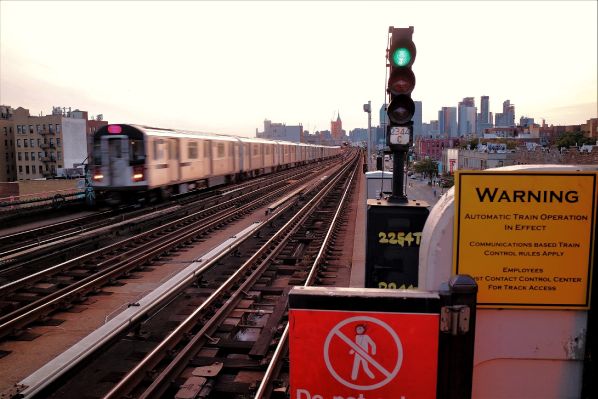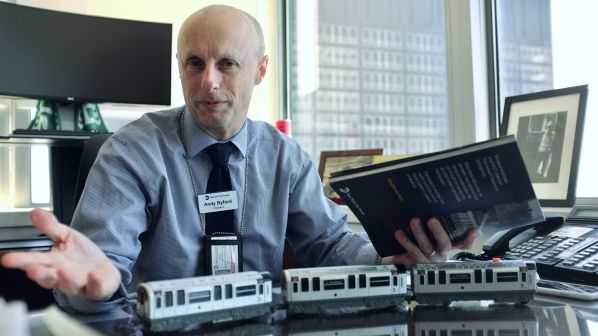NEW York City’s iconic subway has received a barrage of criticism in recent years. Under-funded and under pressure, the city is in desperate need of solutions to bring its 115-year-old network into a good state of repair and to improve reliability for its 5.5 million daily riders.
The situation came to a head in the summer of 2017. On June 27 a train derailed, injuring 40 people. This followed a series of failures as ageing equipment struggled to cope with demand. State governor, Mr Andrew Cuomo, declared a state of emergency, and promised that a rescue plan by Metropolitan Transportation Authority (MTA) would finally solve the subway’s problems.
Mr Andy Byford is the man charged with doing exactly this. Byford joined the New York Metropolitan Transportation Authority (MTA) as president of New York City Transit (NYCT), the agency responsible for the subway as well as the city’s buses, paratransit services and the Staten Island Railway, one year ago. Byford has forged a rail transit career on three continents, joining NYCT after a five-year term as CEO of the Toronto Transit Commission (TTC), North America’s third-largest transit system.
“The greatest city in the world relies on a transit system in a state of emergency. It needs a fundamental recast, a top-to-bottom modernisation.”
Byford began his transit career at London Underground where, over 14 years, he rose to the position of general manager of the Central, Bakerloo and Victoria lines, overseeing increases in customer satisfaction and operational performance. He then became chief operating officer of NSW RailCorp, operator of Australia’s largest transit system, in Sydney. At TTC, among other accomplishments, he introduced Communications-Based Train Control (CBTC) and completed the $US 2.5bn Toronto York Spadina Subway extension.
By his own account, New York may very well be Byford’s last stop, as it has been his lifelong ambition to run the city’s metro.
When he arrived NYCT was in the midst of a crisis. “The greatest city in the world relies on a transit system in a state of emergency,” he told IRJ. “It needs a fundamental recast, a top-to-bottom modernisation. It’s an honour to be trusted with the huge responsibility to modernise the system and bring it to the high levels of performance and customer service that New Yorkers truly deserve and rightfully expect.”
The ambitious “Fast Forward” programme, which Byford initiated soon after his arrival, will cost an estimated $US 20-30bn - a figure the city and state’s politicians are finding difficult to swallow. Never mind, says Byford: “We need to bite the bullet and get on with the work.”
Among the critical projects are deploying CBTC across the entire system - which still uses automatic block signals and enforces train movements with pneumatic trip-stops - within 10 years. “We’ve got to embrace new technology,” Byford says. “At our current pace, deploying one line at a time, it will take 50 or 60 years. That’s not acceptable. We need to go out and buy proven products, and we are open for business. Try me.”
In a recent CBS 60-Minutes documentary profile, Byford comes across as accessible and down to earth, almost to the point of being disarming. Wearing a name tag and a warm smile, he rides the trains, talking to customers and employees, even picking up a piece of trash on a station platform. It wasn’t a performance for the cameras. It’s who Byford is. Anyone who doubts whether this genteel Brit can survive in a rough place like New York City, shouldn’t. He’s just being himself. No pretences. And only one agenda: fix what’s broken.
While funding the Fast Forward plan to aggressively modernise the entire subway system over the next few years appears an almost impossibly high hurdle, Byford is undeterred.
“Our efforts at making our case continue unabated,” he says. “We know our first priority is to get our customers from A to B, quickly, safely, and reliably, but there are also improvements that we can deliver right now to other aspects of our service.”
Byford’s quarterly Customer Commitment “is simple and concise,” he says. “It’s a straightforward list of items we’re vowing to get done right away, things for which our customers can hold us to account. It’s our way of being transparent and showing New Yorkers that we can create incremental improvements that make a difference in their everyday lives.”
Among these items are refurbishing turnouts at critical, high-traffic locations; installing new public address systems at 13 stations; deep cleaning of 15 stations in critical need of attention; and installation of continuously welded rail.
Fast Forward focuses on four major priorities that Byford identified on his first day in office: “transforming the subway, reimagining the city’s public bus network, improving accessibility for all modes, and engaging and empowering NYC Transit’s workforce to deliver the best service possible.”
These priorities are underpinned by “three foundations of corporate philosophy” that Byford and his staff “are working to make the norm at NYCT: agility and accountability; safety, security and resilience; and customer service and communication.”
“As I said when my appointment was announced, what is needed isn’t mere tinkering, a few tweaks here and there,” Byford wrote in the Fast Forward plan’s opening statement. “What must happen is sustained investment on a massive scale if we are to deliver New Yorkers the service they deserve and the transit system this city and state need. Now is the time to think big and transform our network so it works for all New Yorkers.”
Plan highlights
Among the plan’s highlights are:
- Installation of new signalling and track infrastructure to optimise reliability, performance and safety: the plan says that within five years, CBTC will be installed on five additional lines, benefitting 3 million daily riders.

Byford is targeting the rollout of CBTC on 11 additional New York subway network lines within the next 10 years. Photo: Shutterstock/hopenamtogo Within 10 years, CBTC will cover 11 additional lines, benefiting 5 million daily riders. This work will also require refurbishment, replacement or upgrading of myriad supporting infrastructure and equipment such as power systems, shops and yards, and rolling stock.
- Deliver a fully accessible subway system: within five years, more than 50 new stations will be made accessible, ensuring that all subway riders will not be more than two stops away from an accessible station. Within 10 years, this will expand to a total of more than 130 additional stations, with the remaining possible stations completed by 2034. Elevator and escalator maintenance and repairs are also being enhanced along with improvements to customer services, including new sensitivity training for all employees in the next year, and better information about elevator and escalator outages and alternative routes.
- Critical structural and functional repairs, maintenance and improvements: these will be performed at more than 150 stations over the course of five years, and at more than 300 stations within 10 years.
- A new fleet of trains: within five years, riders will be benefit from more than 650 new subway cars, and more than 1200 refurbished vehicles. Within 10 years, the plan calls for another 3000 new subway vehicles.
- Improving efficiency and reducing costs: the plan embraces the efficient use of capital funding and overhauling processes to enable faster, more efficient project delivery as well as improving measurement, tracking and public reporting on performance. This includes clearer lines of accountability and strengthened project management to improve adherence to schedule and budget, improving the design process to reduce unnecessary change orders, simplifying the procurement process, and modernising the supply chain.
- Embracing and increasing capacity for innovation: the plan will support a new “innovation unit” that incubates new solutions to improve the customer experience and operational efficiency, improve the integration of new technology in operations, explore the increased use of PPPs and pursue and expand upon recommendations from MTA’s Genius Transit Challenge.
- Advancing environmental sustainability and resilience: the plan maintains efforts to require environmental sustainability in new construction including using Leadership in Energy and Environmental Design (LEED)-certified specifications, and building upon an extensive asset recovery and recycling programmes that diverts 50,000 tonnes of waste from landfills annually. Resiliency equipment and planning efforts started after Superstorm Sandy in 2012 will continue.
- A modern approach to safety: NYCT is working closely with the New York City Police Department to support its expansion of a “neighbourhood policing” model to the subway network, as well as to enhance enforcement against assault and other crimes in the transit system. NYCT will also establish a 24/7 confidential safety reporting hotline for employees to strengthen the safety culture. Enhanced security measures using the latest detection technologies and collaboration with law enforcement will continue to keep the transit system and its users safe.
- Improving customer service and communication: the plan includes a new “Strategy and Customer Experience” division to ensure the interests of customers are considered in all decisions. Improvements include performance tracking dashboards, train and bus arrival info, wayfinders and roaming station agents. Within the next five years, screens will be installed at all stations and on more than 3000 subway cars to provide real-time location-specific information. The authority will also launch a new mobile-friendly website and app. The quality assurance of public address systems in stations, on trains and on buses will be strengthened.
Whether NYCT can deliver these improvements really depends on whether the funds are available. Byford has a track record for delivery and has put forward the blueprint. It is now up to the politicians to agree on what is best for the transit-dependent “Big Apple,” its eight million residents, and the hundreds of thousands who pour in each day to work, or enjoy New York’s art, music and culture. It’s a huge task.

